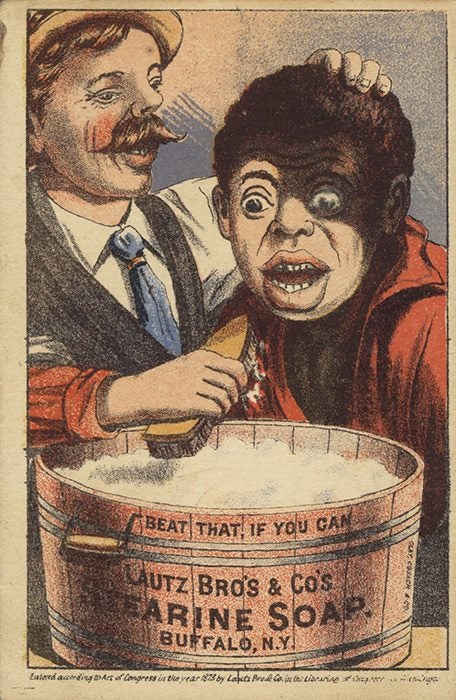
Lautz Bro’s & Co’s advertisement for stearine soap accurately displays the climate of racial affairs in the United States during the 1800s. This advertisement reinforces a cycle of ignorance developed throughout time. The United States has a dark history rooted in haughtiness and advertisements like the one above show what society deemed as normal at the time. I believe this advertisement is disrespectful and shows a lack of humanity from the creators of the ad and everyone who accepted the ad.
Analyzing advertisements is not as simple as labeling the ad ‘good’ or ‘bad’. This is where semiotics, the theory of signs, comes into play. The use of semiotics can help to identify the messages of advertisements whether those messages are in plain sight and/or hidden. An analysis of an advertisement can’t be done without examining its content so let’s start there.
In the advertisement, there are two people, an older White man and a younger African-American man, and a large bucket of soap. The White man is holding a brush and appears to be washing the African-American man. The White man’s clothing, a fedora, a suit vest paired with a button down shirt, and tie, indicates that he has some sort of wealth. The African-American man is wearing an open collared shirt without any undershirt which would signify that he’s most likely poor. The older man appears to be pleased with what the soap is doing which will be discussed later in the paper. The younger man looks surprised by the effect of the soap as his eyebrows are raised and his eyes are opened wide.
Representation plays a large part in how effective media can be. Stuart Hall’s theory of representation explains that people are not always represented accurately in the media. Even though slavery was abolished by the thirteenth amendment in 1865 (seven years prior to the creation of this advertisement), certain views and habits were already ingrained in society at the time. African-american and people of color were viewed as inferior and regarded as property while White men and women were deemed superior to everyone else during that time. This advertisement showcases the stereotypical appearance of an African-American person: big lips, wide nose, coarse hair. The person who’s holding the brush appears to be a white American man. The way he’s holding the other man signifies a sign of power/ownership.
The use of color in Lautz’ advertisement is a significant factor in pushing their message. If the advertisement was in black and white, it would just look like a regular soap ad without a deeper/hidden message. The only way to analyze a grayscale advertisement would be to identify its linguistic message. Roland Barthes, a French literary theorist, defines a linguistic message as the textual component that works alongside visual representational aspects of an image which can direct the viewer toward a clear interpretation. Barthes also used semiotic terms, coded iconic message and non-coded iconic message, to get a deeper understanding of media. A coded iconic message is the “connotational” (subjective, cultural, symbolic, ideological) meaning that can be understood from a form of media. A non-coded iconic message the “denotational” (objective, literal, perceptual, innocent) meaning that can be understood from the form of media presented; It is what it is.
In this case, the non-coded iconic message is the soap will do what’s expected of soap: make the person using it as clean as possible. Lautz Bro’s & Co’s was demonstrating the power dynamic of the United States occurring at the time. This directly relates to the coded-iconic message of the advertisement. There was a nationwide consensus that the lighter the skin, the better a person was treated. Look at slavery: the overall conditions were terrible; however, the lighter-skinned slaves were treated better than the darker-skinned slaves. There was a clear disdain for people with melanated skin. What’s one way to deal with something/someone you don’t respect? You erase it from your sight which is exactly what Lautz Bro’s & Co’s is insinuating their soap would do. The text, “Beat That, If You Can”, on the bucket of soap presents a challenge to their competitors. “We’re promoting a situation that most of the general population would like to see, so let’s see if you can create something better.” could’ve possibly been their thought process.
History does tend to repeat itself. People have done exactly what the advertisement is showcasing to themselves voluntarily. A process called skin bleaching allows people to lighten their skin complexion using chemical substances. Baseball legend, Sammy Sosa, and Jamaican dancehall artist, Alkaline, are a few examples of people who’ve bleached their skin. This advertisement would cause massive outrage in society today. Granted there is probably still a portion of the population who would agree with the message of the advertisement, the voices in disagreement would certainly be louder. Factoring in the emergence of cancel culture, this advertisement would not last long at all.
Works Cited
Gershon, Livia. “The Racism of 19th-Century Advertisements .” JStor Daily, 28 Jan. 2019, daily.jstor.org/the-racism-of-19th-century-advertisements/.
Hall, Stuart. The Work of Representation, 1991, pp. 1–5, Accessed 20 Mar. 2024.
Drafts
https://docs.google.com/document/d/1nV6H3FOm-hetJOJZykLV4ioyBHIE2YRPnifLHC3JGxA/edit?usp=sharing
https://docs.google.com/document/d/1xA-bRIYl4PHmv9bVBQnWA8_WG8-KShfbutyTsHq8ti4/edit?usp=sharing




Leave a Reply